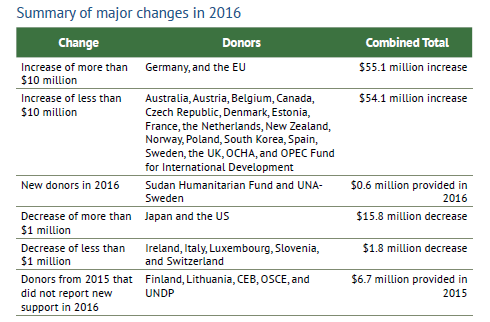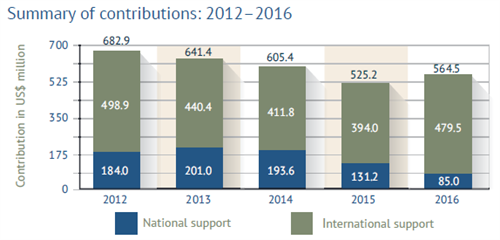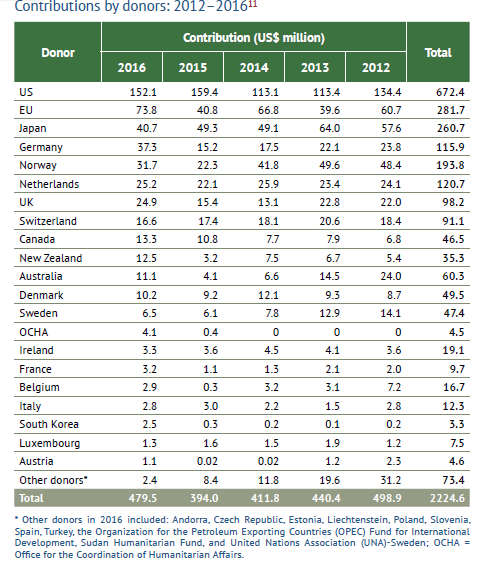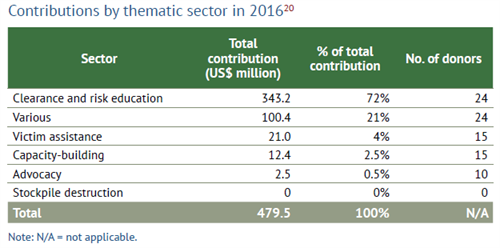Landmine Monitor 2017
Support for Mine Action
Article 6 of the Mine Ban Treaty on international cooperation and assistance recognizes the right of each State Party to seek and receive assistance from other States Parties in order to fulfill its treaty obligations. This chapter focuses on financial support for mine action provided for calendar year 2016 by affected countries and international donors. Cooperation and assistance, however, is not only limited to financial assistance. Other forms of assistance can include the provision of equipment, expertise, and personnel, as well as the exchange of experience, know-how, and best-practice sharing.
2016 Figures and Trends
- Thirty-two donors and 11 affected states reported contributing US$564.5 million in international and national support for mine action in 2016 [1]; this is $39.3 million more than the revised 2015 amount (a 7% increase).
- International contributions accounted for 85% of overall support for mine action in 2016, while states’ contributions to their own national mine action programs accounted for the remaining 15% of global funding.
- Donors contributed $479.5 million in international support for mine action to 40 affected states and three other areas. This represents an increase of $85.5 million from 2015 (a 22% increase).
- National contributions: The Monitor identified 11 affected states that provided $85 million in contributions to their own national mine action programs, $46.2 million less than in 2015 (a 35% decrease), when 14 affected countries reported contributing $131.2 million.
- Contributions from the top five donors—the United States (US), the European Union (EU), Japan, Germany, and Norway—amounted to more than $335 million and accounted for 70% of all international funding.
- The top five recipient states—Iraq, Afghanistan, Croatia, Cambodia, and Lao PDR—received a combined total of nearly $259 million, representing 54% of all international contributions.
- International funding was distributed among the following sectors: clearance and risk education (72% of all funding), victim assistance (4%), capacity-building (2.5%), and advocacy (0.5%). The remaining 21% was not disaggregated by the donors.
International Contributions in 2016
In 2016, 32 donors contributed $479.5 million in international support for mine action in 40 affected states and three other areas, an increase of $85.5 million (22%) from the revised $394 million reported in 2015.[2]
After three years of declining support (a 26% decrease was recorded between 2012 and 2015), total international support provided in 2016 represents the third-highest level of the past decade—after the $498.9 million provided in 2012, and the $480.4 in 2010.

Pledges in 2016 and 2017
At the Maputo Review Conference in June 2014, States Parties committed to complete their respective time-bound obligations by 2025. This commitment has led to a number of initiatives and announcements aiming at strengthening international cooperation and assistance, and promoting the need for predictable adequate funding in order to meet the goal of a mine-free world by 2025.
In 2016, mine action donors reiterated their commitments to provide resources to support mine action efforts in the coming years through three pledging conferences:[3]
- The International Pledging Conference for the Implementation of the Anti-Personnel Mine Ban Convention, hosted by Chile in Geneva in March;
- The Pledging Conference in support of Iraq, co-hosted by Canada, Japan, Germany, Kuwait, the Netherlands, and the US in Washington, DC, in July; and
- The Global Demining Initiative for Colombia ministerial-level meeting, co-hosted by Norway and the US in New York City in September.
In addition to these pledging conferences, New Zealand and the US both announced significant increases in their funding for clearance and survey efforts in Lao PDR.
In 2017, some donors also renewed their commitment to providing financial resources:
- In February, 36 States Parties, two states not party, the EU, as well as non-governmental and international organizations attended the Second Pledging Conference for the Implementation of the Mine Ban Treaty, hosted by Austria in Geneva. In total, 19 States Parties[4] made pledges to the treaty’s Implementation Support Unit and sponsorship program.
- In March, Canada pledged new funding to support risk education, clearance, and capacity-building activities in Iraq, Ukraine, and Sri Lanka for a combined total of $5.8 million.[5]
- In April, the United Kingdom (UK) announced a £100 million ($124 million) aid package to support landmine clearance projects in Afghanistan, Cambodia, Somalia, and South Sudan over the next three years.[6] This represents a tripling in its contribution to mine action.[7] That same month, the Netherlands also pledged €2 million (US$2.1 million) for training and the deployment of local demining teams in liberated areas of Syria.[8]
- In November, Germany renewed its support to clearance operations in newly liberated areas of Iraq with a contribution of €7 million (some $8 million).[9]
These pledging conferences and announcements seem to indicate a political commitment from some donors to fund mine action in select heavily affected countries in the future. But, while an increase has been recorded in mine action funding in 2016, it is too early to determine if this will be sustained.
Donors in 2016
In 2016, 25 Mine Ban Treaty States Parties, two states not party, the EU, and four international institutions[10] contributed a total of $479.5 million to mine action.
The majority of the funding came from just a few donors, with the top five donors contributing a total of $335.6 million, or 70% of all international funding for 2016. The US remained the largest mine action donor with $152.1 million and alone provided about one-third of all international mine action support in 2016. The EU ranked second with $73.8 million, or 15% of all contributions, while the next three donors—Japan, Germany, and Norway—provided more than $30 million each. Another 11 donors contributed less than $1 million each, compared to 16 in 2015.
Support from States Parties in 2016 accounted for half of all donor funding, with 25 countries providing some $246 million. This represents an increase from the $190 million recorded in 2015.
In 2016, the EU and its member states[12] contributed a total of $194 million and accounted for 40% of the total international support, up from $113.5 million provided in 2015 (33% of the total international funding for that year).
Twenty donors contributed more in 2016 than they did in 2015; including a $33 million increase from the EU and a $22 million increase from Germany. Additionally, Norway, the UK, and New Zealand increased their assistance by more than $9 million each. Two new donors were also identified in 2016: the Sudan Humanitarian Fund, and UNA-Sweden.
In contrast, seven donors decreased their funding, led by Japan (down $8.6 million) and the US (down $7.3 million). Five donors from 2015 did not report any contribution to mine action in 2016: Finland, Lithuania, Council of Europe Development Bank (CEB), the Organization for Security and Cooperation in Europe (OSCE), and the UN Development Programme (UNDP).

As shown in the table below, changes in the exchange rates between national currencies and the US dollar affected the US dollar value of some contributions. For instance, Japan’s contribution dropped by 17% in US dollar terms during 2016, despite decreasing by 26% in national currency terms.
Similarly, whereas Canada, Norway, and the UK reported increases in their mine action contributions in 2016, after conversion into US dollars, increases were less pronounced, although they remain significant in most instances.
Funding paths
Donors contributed to mine action through several trust fund mechanisms, notably the UN Voluntary Trust Fund for Assistance in Mine Action (VTF) administered by UNMAS and ITF Enhancing Human Security (established by the government of Slovenia and formerly known as the International Trust Fund).
In 2016, contributions to the VTF totaled $63 million from 21 donors, compared to some $52.6 million from 19 donors in 2015.[14] Several small donors used the VTF to contribute to mine action.[15] Seven donors and the OPEC Fund for International Development allocated $8.2 million in 2016 through the ITF for mine action programs in nine states and one area, as well as for global activities.[16]
Recipients
A total of 40 states and three other areas received $426.8 million from 31 donors in 2016. A further $52.7 million, designated as “global” in the table below, was provided to institutions, NGOs, trust funds, and UN agencies without a designated recipient state or area.
Iraq received the largest amount of funding ($79.7 million) from the largest number of donors (16). Eleven states and one area, or 28% of all recipients, had only one donor.[17]
As in previous years, a small number of countries received the majority of funding. The top five recipient states—Iraq, Afghanistan, Croatia, Cambodia, and Lao PDR—received 54% of all international support in 2016.

In 2016, 32 states and areas experienced a change of more than 20% in funding compared to 2015, including 13 recipients receiving less support and six recipients receiving no new support. Croatia was the recipient with the largest increase, receiving $50.7 million more than in 2015, following the disbursement of EU funds for clearance activities at the border with BiH as well as a project on mine clearance of agricultural land running until 2020.[18] While being the fifth largest recipient of international support in 2016, Lao PDR was the recipient with the largest decrease, receiving $7.4 million less than in 2015.[19] These fluctuations may be a reflection of shifts in donor priorities and changes in local situations.
While donor funding frequently is used for national activities, implementation is often carried out by an array of partnering institutions, NGOs, trust funds, and UN agencies. Organizations that received a significant proportion of contributions in 2016 included HALO Trust ($25.2 million), Norwegian People’s Aid ($20.6 million), Mines Advisory Group ($20.5 million), the International Committee of the Red Cross (ICRC) ($15.2 million), the Geneva International Centre for Humanitarian Demining ($10.9 million), DanChurchAid ($10.7 million), and Handicap International ($10 million).
Funding by thematic sector
In 2016, 72% of mine action funding supported clearance and risk education activities, while support to victim assistance represented 4% of the total international support to mine action.
“Various” funding represented 21% of all international support to mine action. This includes contributions not disaggregated by the donors, as well as funding not earmarked for any sectors.
Clearance and risk education
In 2016, $343.2 million, or 72% of all reported support for mine action, went toward clearance and risk education activities. This represents an increase of more than $91 million from 2015.
Five of the 10 largest donors—the US, the EU, Norway, Germany, and the UK—provided nearly three-quarters of all support to clearance and risk education ($256 million).
Many donors reported clearance and risk education as a combined figure. Twenty-two donors did, however, indicate contributions specifically for clearance activities, providing a total of $169.3 million in 31 countries and other areas (19 States Parties, one signatory, nine states not party, and two other areas).
Thirteen donors reported contributions totaling $6 million specifically for risk education projects in 11 countries. Myanmar received the most risk education-specific funding with $1.4 million.
Victim assistance
Direct international support for victim assistance activities remained below the level of most previous years, and decreased significantly as a percentage of total mine action funding. Based on information available as of November 2017, in 2016, $21 million was reported, up slightly from $19.7 million in 2015. This represents just 4% of all reported support for mine action, compared to some 5% or 6% in 2015, 2014, and 2013.
Fifteen[21] donors reported contributing to victim assistance projects in nine States Parties, five states not party, and one other area.[22] Most mine-affected countries did not receive any direct international support for victim assistance. Funding for victim assistance activities, however, is especially difficult to track because many donors report that they provide support for victims through more general programs for development and for the rights of persons with disabilities. Since such contributions are not disaggregated, it is not possible to include them in Monitor reporting.
The top three victim assistance donors—Germany, New Zealand, and Switzerland—provided 64% ($13.5 million) of all victim assistance funding in 2016.
Nine donors reported contributing $13.3 million, half of all support to victim assistance in 2016, through the ICRC or national Red Cross and Red Crescent societies.
Advocacy & capacity-building
In 2016, less than 1% of all reported support for mine action went toward advocacy activities ($2.5 million). Of the 32 donors reporting international contributions to mine action, 10 reported supporting advocacy activities.
Ten donors provided $12.4 million—2.5% of all international support—to support capacity-building activities in eight States Parties, and three states not party.
National Contributions in 2016
While there has been more transparency from affected states, overall national contributions to mine action continue to be under-reported. Few States Parties report national funding in their annual Article 7 reports.[23] States Parties such as Algeria[24] and Iraq, as well as states not party India, Sri Lanka, and Vietnam—all mine-affected states with significant contamination and major clearance operations, usually conducted by the army—have never reported annual expenditures.
Eleven affected states reported $85.0 million in contributions to mine action from their national budget in 2016, $46.2 million less than the $131.2 million reported in 2015 (a 35% decrease).[25] As in 2015, this decrease is largely the result of less support provided by Angola to its mine action program, with a total contribution amounting to $24.5 million in 2016 (60% less than the $60 million provided in 2015). Nevertheless, Angola still accounted for approximately 30% of all national funding for 2016.
In 2016, three states completely funded their own mine action program: Chile, Ecuador, and Mauritania. Additionally, three States Parties reported funding more than half of their own mine action programs: BiH (59% of total program cost), Chad (97%), and Sudan (54%).

Five-Year Support to Mine Action 2012–2016
Over the past five years (2012–2016), total support to mine action amounted to some $3 billion, an average of about $603 million per year.
Although data about national support remains incomplete, such support has accounted for about one-quarter of total mine action funding over the period, and amounted to approximately $794.8 million.
International support totaled $2.2 billion, an average of $445 million per year, and represented 74% of all support. Three donors—the US, the EU, and Japan—contributed $1.2 billion, more than 50% of total international support. Three other donors—Norway, the Netherlands, and Germany—contributed more than $100 million each. Support from States Parties accounted for 55% of all international funding with $1.2 billion provided.
Between 2012–2016, the top four recipients—Afghanistan ($310.2 million), Iraq ($234.8 million), Lao PDR ($192 million), and Cambodia ($148.7 million)—received 40% of all international contributions.

[1] This figure represents reported government contributions under bilateral and international programs for calendar year 2016, as of November 2017. All dollar values presented in this chapter are expressed in current dollars. Mine action support includes funding specifically related to landmines, cluster munitions, and explosive remnants of war (ERW) but is rarely disaggregated as such. State reporting on contributions is varied in the level of detail and some utilize a fiscal year other than the calendar year. The total amount of international support for 2015 was revised to include contributions from Canada, the United States (US), and the European Union (EU) that were not previously reported by the Monitor.
[2] Data for 2016 on international support to mine action is based on reviews of Mine Ban Treaty Article 7 reports, Convention on Cluster Munitions Article 7 reports, Convention on Conventional Weapons (CCW) Amended Protocol II Annual Reports, ITF Enhancing Human Security Annual Report 2015, UNMAS Annual Report 2015, and answers from donors to questionnaires. Sixteen of the 25 States Parties documented in this chapter reported international funding for mine action in a Mine Ban Treaty Article 7 report for 2016, compared to 13 out of 27 States Parties in 2015.
[3] See Monitor factsheet, “Extraordinary Pledges to Support Mine Action in 2016,” 22 November 2016, www.the-monitor.org/media/2388355/2016-Pledging-Conferences-fact-sheet_final.pdf.
[4] Algeria, Australia, Austria, Canada, Belgium, Estonia, France, Finland, Germany, Indonesia, Italy, Japan, Luxembourg, the Netherlands, New Zealand, Sweden, Switzerland, Turkey, and the United Kingdom (UK). Mine Ban Treaty, Second Pledging Conference, 28 February 2017, bit.ly/MBT2ndPledgeConf.
[5] Government of Canada, “Canada’s support for demining efforts,” 3 April 2017, www.canada.ca/en/global-affairs/news/2017/04/canada_s_supportfordeminingefforts.html. Exchange rate for March 2017: C$1.3437=US$1. US Federal Reserve, “Foreign Exchange Rates (monthly),” 1 May 2017, www.federalreserve.gov/releases/g5/20170501/.
[6] Department for International Development (DFID), “UK triples support for action against landmines on 20th anniversary of Princess Diana’s iconic Angola visit,” Press release, 4 April 2017, bit.ly/UKtriplesMA. Average exchange rate for April 2017: £1=US$1.2639. US Federal Reserve, “List of Exchange Rates (Monthly),” 3 July 2017, www.federalreserve.gov/releases/g5/20170703/.
[7] In comparison, from 2013–2015 the Landmine Monitor reported that the UK contributed a total of £32.7 million ($51.3 million).
[8] Government of the Netherlands, “Extra support for demining in Syria,” 5 April 2017, www.government.nl/latest/news/2017/04/05/extra-support-for-demining-in-syria. Average exchange rate for April 2017: €1=US$1.0714. US Federal Reserve, “List of Exchange Rates (Monthly),” 3 July 2017, www.federalreserve.gov/releases/g5/20170703/.
[9] UNMAS, “The Government of Germany continues to support the clearance of explosive hazards in the newly retaken areas of Iraq,” 5 November 2017, www.reliefweb.int/sites/reliefweb.int/files/resources/UNMAS EN.pdf. Average exchange rate for October 2017: €1=US$1.1755. US Federal Reserve, “List of Exchange Rates (Monthly),” 1 November 2017, www.federalreserve.gov/releases/g5/current/default.htm.
[10] South Korea and the US are the two states not party. The four international institutions are the Organization for the Petroleum Exporting Countries (OPEC) Fund for International Development (OFID), the Organization for Security and Cooperation in Europe (OSCE), United Nations Association (UNA)-Sweden, and the UN Office for the Coordination of Humanitarian Affairs (OCHA).
[11] The amount for each donor has been rounded to the nearest hundred thousand. The total amount of international support for 2015 was revised to include contributions from Canada, the US, and the EU that were not previously reported by the Monitor. Totals for 2014 and 2013 were also rectified slightly as a result of revised US funding totals.
[12] Sixteen EU member states provided funding in 2016: Austria, Belgium, Czech Republic, Denmark, Estonia, France, Germany, Ireland, Italy, Luxembourg, the Netherlands, Poland, Slovenia, Spain, Sweden, and the UK.
[13] Average exchange rates for 2016: A$1=US$0.7445; C$1.3243=US$1; DKK6.7276=US$1; €1=US$1.1096; ¥108.66=US$1; NZ$0.6976=US$1; NOK8.3936=US$1; £1=US$1.3555; SEK8.5541=US$1; and CHF0.9848=US$1. US Federal Reserve, “List of Exchange Rates (Annual),” 4 January 2017, www.federalreserve.gov/releases/G5a/current/default.htm.
[14] UNMAS, “Annual Report 2016,” March 2017, p. 30, www.mineaction.org/sites/default/files/publications/UNMAS_2016_web_1.pdf.
[15] The small donors included Andorra, Liechtenstein, Poland, and OCHA, as well as the Sudan Humanitarian Fund and UNA-Sweden.
[16] ITF Enhancing Human Security, “Annual Report 2016,” April 2017, pp. 24–25, www.itf.si/upload/publications/itf_ar_2016.pdf.
[17] Albania, Azerbaijan, Benin, Central African Republic, Chad, Croatia, Marshall Islands, Peru, Senegal, Serbia, Solomon Islands, and other area Somaliland.
[18] In 2016, the EU reported contributing a total of €45.8 million ($50.7 million) in mine action funding in Croatia: €5.8 million ($6.4 million) for demining activities along the border with BiH, €5 million ($5.6 million) for a demining program in war affected areas, and €34.9 million ($38.7 million) for a project on mine clearance of agricultural land. Response to Monitor questionnaire by Frank Meeussen, Disarmament, Non-Proliferation and Arms Export Control, European External Action Service, 30 September 2017.
[19] The sharp decrease in international support for mine action in Lao PDR in 2016 is the result of changes in donors’ contributions, notably Japan which provided less than $600,000 in 2016 (in comparison from 2012-2015 Japan contributed an average of $12 million annually).
[20] In 2015, international support was distributed among the following sectors: clearance and risk education ($251.6 million, or 64% of total international support), victim assistance ($19.7 million, or 5%), advocacy ($2.2million, or 0.5%), capacity-building ($6.7 million, or 2%), stockpile destruction ($2.5 million, or 0.5%), and various activities ($111.3 million, or 28%). The “0” in stockpile destruction in 2016 does not mean states expended no funds for that activity, but rather that no new international support was identified as distributed.
[21] Victim assistance donors included: Australia, Austria, Germany, Italy, Japan, Liechtenstein, Luxembourg, the Netherlands, New Zealand, Norway, Slovenia, Sweden, Switzerland, Turkey, and the OFID. Data for 2015 was also revised—based on new figures that no longer detailed dedicated victim assistance funding—resulting in a decrease from the $24.2 million recorded in Landmine Monitor 2016.
[22] States Parties recipients of international assistance for victim assistance were: Afghanistan, Cambodia, Chad, Colombia, Iraq, Mozambique, Somalia, South Sudan, and Ukraine. States not party that received international assistance for victim assistance were: Lao PDR, Myanmar, Palestine, Syria, and Vietnam. Kosovo was the sole other area that received victim assistance funding.
[23] Only four of the 11 affected states analyzed in this chapter reported national funding for mine action in a Mine Ban Treaty Article 7 report for 2016: Lebanon, Mauritania, Sudan, and Zimbabwe.
[24] Algeria reported completion of mine clearance in 2017.
[25] Angola, BiH, Chad, Chile, Croatia, Ecuador, Lao PDR, Lebanon, Mauritania, Sudan, and Zimbabwe.




